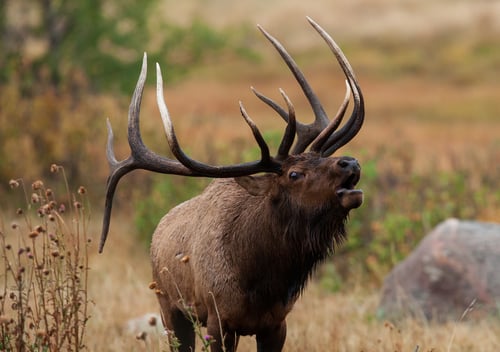The bugle of the male elk is considered by some to be one of the most magical calls in nature, and considered by others to be one of the more haunting. Most commonly heard around dusk and dawn between the months of September and October, the bugle of an elk is an incredible sound to hear in the wild. Generally, it sounds somewhat like a low human scream. However, describing it is a challenge as there are few sounds like it. So why is it that elk bugle? And why do we really only hear it in the fall?

Most commonly heard around dusk and dawn between the months of September and October, the bugle of an elk is an incredible sound to hear in the wild.
The bugle is not the only sound that elk make. Female elk, known as cows, make noises known as barking, in addition to some lower frequency calls which are primarily used to communicate with their young and alert each other of danger. These sounds are loud, but they are not as loud as a bugle, and they do not carry as far. Male elk, known as bulls, make an assortment of these noises as well, but when the fall hits, they begin to bugle. So why do they bugle only in the fall, and why do they do it? The months of September and October mark the rutting, or mating season for elk. This is the period of time when the bulls are trying to impress the cow in hopes of mating. The mating desire causes the bulls to battle other bulls for female attention by ramming their antlers together and wrestling until one or the other is victorious. Essentially, the primary purpose of the bugle is to alert other elk in the area that there is a buck nearby and that he is ready for the mating season.
To be ready for the mating season, a bull needs to be large enough to be able to wrestle other bulls. This means that he will be around two years old when he begins this annual ritual. The age of a bull can also contribute to when in the year they start bugling. Bull elk older than four years old generally start bugling as early as mid-August. Meanwhile, the younger bulls who are just starting to bugle generally do not start until closer to mid-September. During this time period, elk cows and their calves will be beginning to form herds, generally with one bull per herd. This creates another reason for the bull to bugle, as other bulls without a herd tend to follow along the edges of the herd in hopes of attracting a cow to leave the group.
Overall, there are two primary reasons for the unique seasonal call of the elk; to assert dominance, and to try to attract a mate. Whether you hear the call in the wild, or just hear it on the television, the bugle of an elk is a mystifying sound that will undoubtedly send shivers down your spine.
Jessica Whitesell is a summer naturalist at Walking Mountains Science Center and is an avid fan of ungulates (hoofed mammals). While goats are her favorite ungulate, she considers seeing any type of hoofed mammal in the wild to be one of the most exciting possible day to day events.







